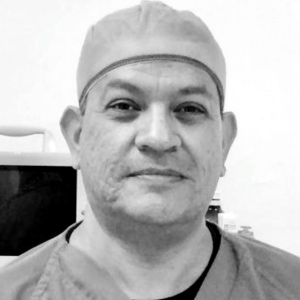Blocked Tear Ducts: Characteristics and Treatment


Reviewed and approved by the doctor Nelton Ramos
When blocked tear ducts occur, then there is either a partial or complete blockage of the draining of tears. This can cause irritation, redness and watering of the eye, as well as infection.
We’ll tell you more about this issue and how to treat it below, so keep reading.
Tear ducts: Basic information
First of all, we need to learn a little about the nasolacrimal duct (also known as the tear duct). This duct is responsible for transporting tears from the tear sac towards the nasal cavity. The sac contains goblet cells that secrete mucus and opens towards the nose.
This is why your nostrils drip as well when you cry. There are even cases of people whose tears “descend” towards their mouth.
Normally, tears drain through very tiny openings in the upper external corner of the eyelids and towards the puncta. The puncta are located in the opposite border of the eye or, in other words, near the nose.
In the case of blocked tear ducts, tears are unable to drain normally. This problem is especially common among newborn babies. In fact, approximately 20% of them experience this issue. But there’s no need to worry. In most cases, the issue resolves itself before a child’s first birthday, even without treatment.
Obstructed tear ducts: Causes and symptoms
If an obstruction occurs in a newborn, the doctor will more than likely affirm it’s a normal condition. What’s more, the medical professional will assure you that the issue will likely go away on its own in the next few months. Therefore, there’s no reason at all for parents to worry.

However, blocked tear ducts can also occur later on in life, that is, during childhood, adolescence, and adulthood. In this case, they’re due to other factors and require specific treatment.
So, what then are the causes of blocked tear ducts? These obstructions occur in any of the “points” where tears drain and are the result of:
- Craniofacial anomalies (abnormal development of the cranium or face), for example, in individuals with Down Syndrome.
- Narrowing of the orifices of the puncta.
- Trauma or bumps to the nose that block the tear duct.
- Nasal polyps (lumps that form in the inner lining of the nose).
- Allergies and chronic sinusitis (these irritate tissue and cause scars that block drainage).
- Conjunctivitis (infection and swelling of the membrane that covers the eye – the conjunctive).
- Tumors that put pressure on the lacrimal system and prevent proper drainage.
When we suffer blocked tear ducts, the main symptom is an abnormal draining of tears. However, this isn’t always easy to identify. Therefore, it’s also important to look out for the symptoms below:
- Recurring eye infections.
- Swelling, reddening, and pain in the inner border around the eye.
- Blurry vision.
- Excessive production of rheum (thin, watery mucus).
- Discharge of mucus from the eyes.
- Fever.
Blocked tear ducts: Diagnosis and treatment
The best way to know if someone is experiencing an obstruction of the tear ducts is by seeing an ophthalmologist. The doctor will perform a complete eye exam, including placing a special liquid on the opening of the eye. If this liquid doesn’t travel to the patient’s throat, then this is an indication of an obstruction. Other studies can include a CT scan or X-ray.

Once the doctor makes a diagnosis, then he or she will prescribe treatment. In many cases, more than one procedure is necessary in order to open the duct and restore proper drainage.
In other cases, it’s simply a matter of waiting until the underlying problem resolves itself. For example, in the case of a fracture in the nasal septum or allergies.
For babies with obstructed tear ducts, the ophthalmologist will likely recommend a massage technique. This will open the membrane that’s responsible for covering the inferior opening of the nose. If this doesn’t work in children, adolescents, or adults, then doctors may use dilation, probing, and irrigation. This involves the use of a probe to “open” the obstructed ducts.
In the most serious or advanced cases, doctors may resort to stenting or intubation. This allows for the widening of the lacrimal passages. If nothing else works, then the next step will be a dacryocystorhinostomy, a surgery that produces a new “drain route” for tears.
It’s very important to diagnose blocked tear ducts early on. This improves the chances of treating them with the least invasive method possible.
When blocked tear ducts occur, then there is either a partial or complete blockage of the draining of tears. This can cause irritation, redness and watering of the eye, as well as infection.
We’ll tell you more about this issue and how to treat it below, so keep reading.
Tear ducts: Basic information
First of all, we need to learn a little about the nasolacrimal duct (also known as the tear duct). This duct is responsible for transporting tears from the tear sac towards the nasal cavity. The sac contains goblet cells that secrete mucus and opens towards the nose.
This is why your nostrils drip as well when you cry. There are even cases of people whose tears “descend” towards their mouth.
Normally, tears drain through very tiny openings in the upper external corner of the eyelids and towards the puncta. The puncta are located in the opposite border of the eye or, in other words, near the nose.
In the case of blocked tear ducts, tears are unable to drain normally. This problem is especially common among newborn babies. In fact, approximately 20% of them experience this issue. But there’s no need to worry. In most cases, the issue resolves itself before a child’s first birthday, even without treatment.
Obstructed tear ducts: Causes and symptoms
If an obstruction occurs in a newborn, the doctor will more than likely affirm it’s a normal condition. What’s more, the medical professional will assure you that the issue will likely go away on its own in the next few months. Therefore, there’s no reason at all for parents to worry.

However, blocked tear ducts can also occur later on in life, that is, during childhood, adolescence, and adulthood. In this case, they’re due to other factors and require specific treatment.
So, what then are the causes of blocked tear ducts? These obstructions occur in any of the “points” where tears drain and are the result of:
- Craniofacial anomalies (abnormal development of the cranium or face), for example, in individuals with Down Syndrome.
- Narrowing of the orifices of the puncta.
- Trauma or bumps to the nose that block the tear duct.
- Nasal polyps (lumps that form in the inner lining of the nose).
- Allergies and chronic sinusitis (these irritate tissue and cause scars that block drainage).
- Conjunctivitis (infection and swelling of the membrane that covers the eye – the conjunctive).
- Tumors that put pressure on the lacrimal system and prevent proper drainage.
When we suffer blocked tear ducts, the main symptom is an abnormal draining of tears. However, this isn’t always easy to identify. Therefore, it’s also important to look out for the symptoms below:
- Recurring eye infections.
- Swelling, reddening, and pain in the inner border around the eye.
- Blurry vision.
- Excessive production of rheum (thin, watery mucus).
- Discharge of mucus from the eyes.
- Fever.
Blocked tear ducts: Diagnosis and treatment
The best way to know if someone is experiencing an obstruction of the tear ducts is by seeing an ophthalmologist. The doctor will perform a complete eye exam, including placing a special liquid on the opening of the eye. If this liquid doesn’t travel to the patient’s throat, then this is an indication of an obstruction. Other studies can include a CT scan or X-ray.

Once the doctor makes a diagnosis, then he or she will prescribe treatment. In many cases, more than one procedure is necessary in order to open the duct and restore proper drainage.
In other cases, it’s simply a matter of waiting until the underlying problem resolves itself. For example, in the case of a fracture in the nasal septum or allergies.
For babies with obstructed tear ducts, the ophthalmologist will likely recommend a massage technique. This will open the membrane that’s responsible for covering the inferior opening of the nose. If this doesn’t work in children, adolescents, or adults, then doctors may use dilation, probing, and irrigation. This involves the use of a probe to “open” the obstructed ducts.
In the most serious or advanced cases, doctors may resort to stenting or intubation. This allows for the widening of the lacrimal passages. If nothing else works, then the next step will be a dacryocystorhinostomy, a surgery that produces a new “drain route” for tears.
It’s very important to diagnose blocked tear ducts early on. This improves the chances of treating them with the least invasive method possible.
All cited sources were thoroughly reviewed by our team to ensure their quality, reliability, currency, and validity. The bibliography of this article was considered reliable and of academic or scientific accuracy.
- Gómez, T., Zaragoza, P., Zato, Y. M., & Ballabrera, R. (2007). Ventana a otras especialidades Obstrucción congénita del canal lagrimal Puntos clave. An Pediatr Contin.
This text is provided for informational purposes only and does not replace consultation with a professional. If in doubt, consult your specialist.








